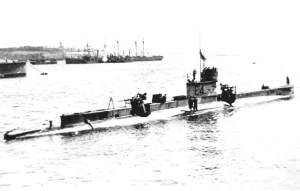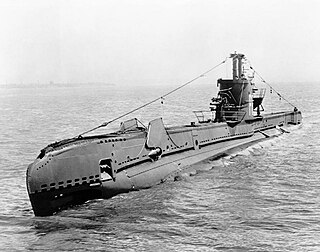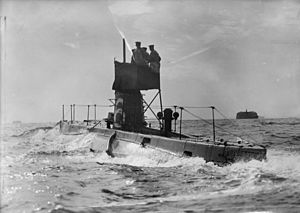
HMS B1 was the lead boat of the B-class submarines built for the Royal Navy in the first decade of the 20th century. The boat survived the First World War and was sold for scrap in 1921.

The B class was a class of 11 submarines, built by Vickers in Barrow-in-Furness for the Royal Navy, and launched in 1904–06. One boat was sunk by a collision in 1912, but the remainder served in World War I. Three boats protected the transfer of the British Expeditionary Force to France in 1914, but were soon relegated to local defence and training duties. Six submarines were in the Mediterranean when the war began and were quickly sent to the Dardanelles to prevent a breakout by the German battlecruiser SMS Goeben and the light cruiser SMS Breslau into the Eastern Mediterranean. B11 ventured into the Dardanelles in December 1914 and sank the elderly Turkish ironclad Mesudiye.

HMS B11 was the last of 11 B-class submarines built for the Royal Navy in the first decade of the 20th century. Completed in 1906, it is best known for carrying out a successful attack on the Ottoman battleship Mesûdiye in the Dardanelles, an action for which her captain received the Victoria Cross. It spent the remainder of its active life serving in the Mediterranean, being converted into a surface patrol boat late in the war. B11 was sold for scrap in 1919.

HMS E4 was a British E class submarine built by Vickers, Barrow-in-Furness, costing £101,900. E4 was laid down on 16 May 1911, launched on 5 February 1912 and commissioned on 28 January 1913. On 24 September 1915 E4 was attacked by the German airship SL3. On 15 August 1916, she collided with sister ship E41 during exercises off Harwich. Both ships sank and there were only 14 survivors, all from E41. Both boats were raised, repaired and recommissioned. She was sold on 21 February 1922 to the Upnor Ship Breaking Company.

HMS E6 was a British E-class submarine built by Vickers Barrow-in-Furness. She was laid down on 12 November 1911 and was commissioned on 17 October 1913. She cost £106,900.

HMS Stonehenge was an S-class submarine of the third batch built for the Royal Navy during World War II. Completed in 1943, she made her initial patrol off Norway and was then transferred to the Far East, where she conducted two war patrols, during which she sank two Japanese ships. On her second patrol, Stonehenge disappeared with all hands and was declared overdue on 20 March 1944. The most probable cause of her sinking is that she hit a mine, but her wreck has never been found.

HMS Simoom was a third-batch S-class submarine built for the Royal Navy during World War II. She was laid down on 14 July 1941 and launched on 12 October 1942.

HMS P222 was a third-batch S-class submarine built for the Royal Navy during World War II. Commissioned in 1942, the boat had an uneventful first war patrol in the Alboran Sea. She intercepted the Vichy French merchant ship SS Mitidja in July, then provided protection for an Allied convoy to Malta in Operation Pedestal the next month. The navy intended that she was to be sighted on the surface by enemy aircraft to discourage potential attacks by surface warships. Though P222 did not encounter enemy forces, the convoy arrived at its destination on 15 August after sustaining severe losses. She then reconnoitred along the coast of Algeria in advance of Operation Torch, and was attacked by a French patrol ship, but sustained no damage.
HMS B2 was one of 11 B-class submarines built for the Royal Navy in the first decade of the 20th century.

HMS B4 was one of 11 B-class submarines built for the Royal Navy in the first decade of the 20th century. The boat survived the First World War and was sold for scrap in 1919.

HMS B5 was one of 11 B-class submarines built for the Royal Navy in the first decade of the 20th century. She survived World War I and was sold for scrap in 1921.

HMS B7 was one of 11 B-class submarines built for the Royal Navy in the first decade of the 20th century. Completed in 1906, she was initially assigned to the Home Fleet, before the boat was transferred to the Mediterranean six years later. After the First World War began in 1914, B7 played a minor role in the Dardanelles Campaign. The boat was transferred to the Adriatic Sea in 1916 to support Italian forces against the Austro-Hungarian Navy. She was converted into a patrol boat in 1917 and was sold for scrap in 1919.

HMS B8 was one of 11 B-class submarines built for the Royal Navy in the first decade of the 20th century. Completed in 1906, she was initially assigned to the Home Fleet, before the boat was transferred to the Mediterranean six years later. After the First World War began in 1914, B8 played a minor role in the Dardanelles Campaign. The boat was transferred to the Adriatic Sea in 1916 to support Italian forces against the Austro-Hungarian Navy. She was converted into a patrol boat in 1917 and was sold for scrap in 1919.

HMS B9 was one of 11 B-class submarines built for the Royal Navy in the first decade of the 20th century. Completed in 1906, she was initially assigned to the Home Fleet, before the boat was transferred to the Mediterranean six years later. After the First World War began in 1914, B9 played a minor role in the Dardanelles Campaign. The boat was transferred to the Adriatic Sea in 1916 to support Italian forces against the Austro-Hungarian Navy. She was converted into a patrol boat in 1917 and was sold for scrap in 1919.

HMS B10 was one of eleven B-class submarines built for the Royal Navy in the first decade of the 20th century. Completed in 1906, she was initially assigned to the Home Fleet, before the boat was transferred to the Mediterranean six years later. After the First World War began in 1914, B10 played a minor role in the Dardanelles Campaign. The boat was transferred to the Adriatic Sea in 1916 to support Italian forces against the Austro-Hungarian Navy. She was anchored in Venice when it was bombed by Austro-Hungarian aircraft on 9 August; B10 was sunk by one of their bombs and became the first submarine to be sunk by an aircraft in history. Salvaged by the Italians, she caught fire while under repair and became a constructive total loss. Her hulk was subsequently sold for scrap.
HMS Murray was a Royal Navy Admiralty M-class destroyer. Ordered before the outbreak of war, she was therefore the first of her class to enter operation during the early months of the First World War. She was also the first vessel of the Royal Navy to carry the name HMS Murray.

HMS Manly was a Yarrow M-class destroyer of the British Royal Navy. Built by the Scottish shipbuilder Yarrow between 1913 and 1914, Manly served during the First World War. She formed part of the Harwich Force in the early years of the war, and then later in the English Channel as part of the Dover Patrol taking part in the Zeebrugge Raid in 1918. She survived the war, and was sold for scrap in 1920.

HMS Matchless was a Royal Navy Admiralty M-class destroyer. Matchless was built by Swan Hunter from 1913 to 1914 and was completed in December that year. She served through the remainder of the First World War, operating in the North Sea as part of the Harwich Force in the early part of the war and later in the English Channel as part of the Dover Patrol, where she took part in both the First and Second Ostend Raids. Despite being badly damaged by a German mine in 1915 and being involved in several collisions, she survived the war, and was sold for scrap in 1921.
HMS Milne was a Royal Navy Admiralty M-class destroyer. Milne was built by John Brown & Company from 1913 to 1914 and was completed in December that year. She served through the remainder of the First World War, at first with the Harwich Force with which she took part in the Battle of Dogger Bank in January 1915, and later with the Dover Patrol, sinking the German submarine UC-26 in May 1917. Milne was sold for scrap in 1921.

HMS Nicator was an Admiralty M-class destroyer which served with the Royal Navy during the First World War. The M class was an improvement on the preceding L class, capable of higher speed. Launched in February 1916, the destroyer fought in the Battle of Jutland between May and June 1916, operating in support of the British battlecruisers in their action against the German High Seas Fleet. Nicator claimed, along with sister ship Nestor, the destruction of a German torpedo boat, likely to be V27. The destroyer also attacked the German battlecruisers and battleships and, although no hits were recorded, kept the German ships from closing with the British. This was crucial to limiting losses to the British battlecruiser fleet. The vessel was subsequently fitted with paravanes for anti-submarine warfare. After the war, the destroyer was placed in reserve and subsequently sold to be broken up in May 1921.















